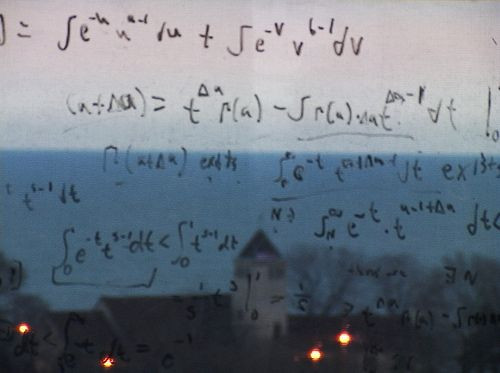Math As Beautiful As Music Or Art? Mathematicians’ Brain Scans Uphold Beauty As Abstract, Emotional

Mathematical equations considered beautiful by mathematicians register in the same parts of the brain as music and art, a team of scientists from the Wellcome Laboratory of Neurobiology at University College London has found in a new study.
Beauty is often talked about in terms of the fleeting and the ethereal. We can’t quite pinpoint what makes something beautiful, but we can come close. A marble sculpture may possess a sort of languid grace, while a bustling symphony may invigorate its audience, and both can be beautiful for different reasons. Now researchers from UCL suggest mathematical equations, too, live in the same neural neighborhood as these commonly held forms of beauty.
“The mathematicians usually profess an emotional experience when they see a beautiful equation,” lead researcher Professor Semir Zeki told Medical Daily. “We therefore suspected that, as with other experiences of the beautiful — in visual arts or in music — there will be activity in the part of the emotional brain — the medial orbitofrontal cortex — that correlates with the experience of beauty.”
A Beautiful Chess Match
Sitting squarely behind your eyes, the orbitofrontal cortex is perhaps the least understood region of the brain. Though scientists believe it’s primarily responsible for decision-making, it’s also been thought to mediate addiction, learning, and emotion. Among those emotions are feelings of enjoyment, derived from experiences that, in prior studies, have been described as beautiful — a painting, or a song. But is beauty limited to the arts?
In human psychology, there’s a phenomenon that occurs among the experts of a given field. While beginners of a certain activity, be it table tennis or chess or the violin, start on their path toward mastery by learning the necessary gross motor skills and basic strategy, experts operate on a different plane. Their arsenal of fine motor skills, perceptual acuity, and discreet reactionary differences all culminate to produce a more robust, and indeed, fundamentally different mental picture.
A famous 1978 study conducted by cognitive scientists Fernand Gobet and Herbert A. Simon showed that chess grandmasters — the highest achievable rank in the game — tend to think in different terms about their moves when time was of the essence. Their subject was Garry Kasparov, the reigning world champion of chess between 1985 and 2000. In the study, Kasparov played against many players simultaneously, taking only 20 seconds per move while his opponents each had roughly three minutes to decide. (Kasparov was off playing his other matches in the meantime.)
At the end of all the matches, he emerged with a ranking so high, Gobet and Simon could count on one hand who in the world could have beaten him by ranking alone. When they analyzed the gameplay, the team deduced it was his picture-recognition abilities, not his move-by-move calculations, that facilitated his dominance. He didn’t solve each board like a math problem, in other words. He read them like open books.
Ugly Numbers
How does this relate to mathematical equations and beauty? While the self-described “mathematically challenged” may only see a pattern of letters, numbers, and funny Greek symbols, math experts see things a little differently — not so unlike an art enthusiast regards a splotchy Jackson Pollock as magnificent. Typically, there is far more behind the work that influences its perceived beauty.
“Mathematicians used to believe that it is simplicity,” Semir Zeki said, “but Paul Dirac,” — an early leader of quantum mechanics and renowned physicist — “believed that beauty in mathematical equations speaks to more fundamental truths, and indeed it is the element of beauty that somehow certifies the truth.”
Unlike Gobet and Simon’s observational approach, Zeki and his colleagues put a group of 15 mathematicians in an fMRI (functional magnetic resonance imaging) scanner as they looked at some 60 mathematical equations. They were told to rate them on a scale of beauty and ugliness. When the team looked at the results of the scan, they found the medial orbitofrontal cortex lit up most often alongside perceived beauty, suggesting to the team that “there is something abstract and emotional about beauty.”
In Zeki’s eyes, the study could hint at a number of implications. On the surface, it helps explain how we humans process notions of beauty — that not all of us regard the same objects as beautiful (a really old idea) because beauty isn’t hardwired into us (a slightly newer idea). It may be the case, Zeki explains, that beauty isn’t necessarily the result of a fascination with symmetry and balance. Beauty could emerge from lopsided, crooked things that still illuminate a deeper truth.
And ultimately, the study could answer “the most fundamental question of all — whether it is through the experience of beauty that we learn something about our universe and our reaction to it,” Zeki said, “since the brain has developed and evolved in this world and what it finds beautiful must also be related to qualities in our environment and to our needs.”
Source: Zeki S, Romaya J, Benincasa D, Atiyah M. The experience of mathematical beauty and its neural correlates. Frontiers in Human Neuroscience. 2014.
Published by Medicaldaily.com



























